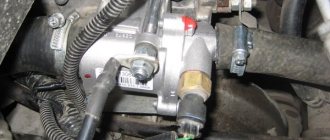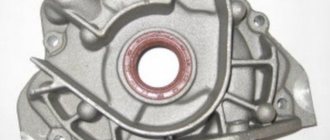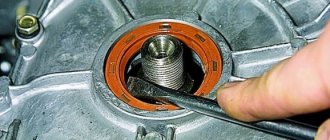The operating principle of the VAZ 2115, 2114, 2113, 2109 thermostat.
What does a thermostat consist of? Let's get a look!
The thermostat consists of a housing, a bypass valve, a main valve, a temperature sensing element (usually located near the main valve) and a spring.
How does the thermostat work on VAZ 2115, 2114, 2113, 2109.
When the car is not warmed up, the thermostat valve is closed, as in the photo. In this case, the coolant moves in a small circle, as in the photo below.
When the machine warms up to operating temperature (87-90 degrees), the temperature-sensitive element slowly begins to heat up, as a result of which the spring compresses, the main valve opens and the liquid flows in a large circle.
HOW DOES THE THERMOSTAT WORK IN A COOLING SYSTEM
The optimal operating temperature for the motor is considered to be 900C. Working under such conditions, efficiency and high engine performance are achieved. To reduce the time it takes for the engine to warm up to operating temperature, a thermostat is installed on the VAZ. During the initial period of engine operation, the antifreeze moves in a small circle without having time to cool and quickly heats up. When the thermostat opening temperature is reached, which is 870C, the thermostat opens and the antifreeze moves through the radiator, where excess heat remains. At a liquid temperature of 1020C, the piston moves another 8 mm and completely opens the way for antifreeze in a “big circle”.
The switching element of the thermostat is the temperature-sensitive element. Expanding when heated, it opens the bypass valve with a piston; when the antifreeze cools, the valve returns to its place, blocking a large circle of movement of the coolant.
Thermostat operation diagram
Changing the thermostat on a VAZ 2114 with your own hands
As long as the car is working properly, the car owner does not think about what is happening under the hood. But at some point, the car engine suddenly begins to overheat for no apparent reason. Most often this means that the thermostat has failed. We will talk about what this device is and how to replace it on a VAZ-2114 car in this article.
Thermostat operating principle
The main purpose of the device is to slow down the flow of coolant into the internal combustion engine. By blocking the coolant flow, the engine warms up to operating temperature. As soon as the temperature mark reaches the operating norm, the VAZ 2114 thermostat opens.
On the side that is closer to the internal combustion engine, there is a special wax ball. The waxy material was chosen for a reason, because when heated it transforms from a solid into a liquid. And as soon as the wax begins to transform at a temperature above 83 degrees, it pushes out the pin, which is located in the cylinder. At this time, the valve opens and coolant begins to flow.
When to change: signs of thermal switch failure
Abstract symptoms can indicate the nature of the disease that has befallen the thermostat:
Stuck in open position (coolant constantly circulates through radiator)
In cold weather, the engine does not heat up well, and at extreme city speeds the coolant temperature drops. Let's say it's -15°C outside, the coolant at idle has warmed up to 70°C, we're driving on a multi-lane road, moving at a speed of 60 km/h, and the temperature gauge needle is either standing still or going down.
Fuel consumption increases noticeably (+ 1-2 liters per 100 km). The wedge is in the closed position (antifreeze moves along the jacket and heater radiator, bypassing the main heat exchanger). There will be no cooling and overheating is inevitable in summer. The fact is clearly clarified by the thermometer needle running upward when the cooling fan is on. Additionally, the “brains” indicate a problem in the form of an illuminated Check Engine icon. Final stop at an intermediate position. Prolonged heating + overheating in hot weather. Slight increase in appetite (within 1 l/100 km).
It is impossible to close a large circle tightly, while the rod moves and the full opening occurs. There is no wedge. This is prevented by deposits accumulated as a result of untimely change of antifreeze, mixing coolant of different classes (for example, on a Hyundai Solaris, antifreeze can only be mixed with G11), and the use of cheap or counterfeit fluids. The fact can be revealed in warm weather only through tubes. In winter, pollution will be indicated by a reluctant rise in temperature from 70°C to 90-95°C when driving on the highway, but in the city there will be no problems with warming up. Seeing such a picture, those who like to cover the radiator grille with cardboard often persuade the owner to insulate the front end. This is definitely useful in cold weather.
Functions and operating principle
It is extremely important for a car to remove excess heat that accumulates in the engine. This is what coolant is primarily designed for.
To reduce this very temperature, the cooling system of the “fourteenth” VAZ model includes a thermostat and an electric cooling radiator fan .
Device diagram
The valve, which is responsible for the flow of coolant, is located inside the housing. It, in turn, has three pipes:
- Input – goes to the pump;
- Two outputs - from the radiator and the engine.
Types of thermostats for VAZ 2114
When replacing a thermostat, car owners ask themselves which thermostat in the VAZ 2114 is better to install: imported or domestic; and which company should you prefer? No one can tell you the absolutely right choice, because every driver pays attention to many factors when choosing spare parts. It all depends on availability, price and other important features.
There are several groups of suitable thermostats that can be found in regular car stores:
- Domestic. Branded thermostats for the VAZ 2114, which will be easy to find on sale. But they do not shine in terms of quality, since they can fail before the guaranteed period or they can even jam and the engine overheats. It is not recommended to replace a thermostat from this manufacturer.
- Chinese. They usually have an attractive exterior, but the inside is much worse than it might seem. During operation, they will perform noticeably worse than domestic thermostats. This option is the most extreme, that is, you will have to take them when nothing else can be found.
- Imported. They are of the highest quality, unlike other manufacturers. Even with this design, the price corresponds to the quality and at the same time they are in greater demand than others. Accordingly, it is recommended to take this thermostat!
Let's consider an imported thermostat for a VAZ 2114 6 hole
Advantages of this particular device:
- this thermostat provides a temperature that is normal for the coolant;
- fewer ligaments on the clamps than on other devices. The standard thermostat is attached to the outlet pipe through a ductile connecting tube;
- this thermostat is initially dismountable for replacing the temperature-sensitive element separately from the body;
- more compact, thus more free space.
The stove already heats at 60 degrees, and at 85 degrees it becomes hot.
There are situations when you cannot find branded thermostats, then you should pay attention to the case material. Based on the composition, you need to take thermostats made of high-quality brass and stainless steel. Their difference can be determined by weight, simply by holding them in your hands.
Be careful when choosing other thermostats. They may be made of zinc alloy, which may not be reliable. Not only can they leak from an impact, but temperature changes also affect them.
Purpose, design and principle of operation of the thermostat
The coolant circulating through the working channels of the engine blocks, its main purpose is to remove excess heat accumulated in the power unit due to the friction of the working elements of the engine and the impact of the high temperature of the exhaust gases passing through the exhaust circuit.
The main elements of the cooling system of the VAZ 2114, which are responsible for lowering the temperature of the antifreeze, are the electric cooling radiator fan and the thermostat.
To understand the principle of its operation, you need to see what the thermostat on a VAZ 2114 looks like. Structurally, it is designed in such a way that the valve that regulates the coolant flow is located inside a housing with three pipes:
- two inputs - from the engine and radiator;
- one day off - to the pump.
The main working element of the valve itself, located inside the thermostat, is a solid heat-sensitive filler, which, when heated, through a rubber insert, acts on the piston that moves the main valve. When it heats up, it opens it, when it cools down, on the contrary, it closes the hole, preventing the flow of antifreeze.
We recommend: Do-it-yourself methods for tuning a gear knob
The thermostat is attached to the engine through a pipe to the cylinder head on the left side, under the air filter. It is connected to the radiator and pump using rubber pipes. On a cold engine, the valve of this coolant flow regulator is closed and after starting, the liquid that begins to be pumped by the pump forces moves along a “small circuit” or “in a small circle.” Both of these expressions are used among motorists. When moving in a small circle, the antifreeze passes through the heater radiator, intake manifold and throttle assembly. Liquid is not supplied to the radiator; the valve cuts off this path.
As the engine heats up, the coolant takes away some of the heat, heats up and, passing in a “small circle” through the thermostat, heats the temperature-sensitive element. The piston begins to move and open the main valve. This begins to happen when the liquid temperature reaches 87 degrees. In this case, part of the coolant begins to circulate through the radiator. When the temperature reaches 102 degrees, the valve opens completely, moving eight millimeters. In this mode, the entire coolant flow rushes in a “large circle” through the cooling radiator.
Experts recommend checking the operation of the thermostat without removing it from the car. To do this, after starting the engine, you need to touch the lower pipes coming from the radiator with your hands. They should be cold until the temperature rises above eighty degrees. As soon as the temperature rises above 85 degrees, the tubes should begin to heat up and after a while you can feel that the “large circle” circulation is working. The tubes should get quite hot.
If the lower pipes leaving the radiator continue to remain cold, it means the main valve has not opened and the thermostat is faulty. A malfunction of this regulator may also be indicated by the fact that the lower tubes begin to heat up almost immediately after starting the engine. This indicates that the valve is open and does not close when cold.
In both cases, a thermostat failure does not bring anything good for the engine. In the case when the valve is open, the antifreeze, passing in a “large circle,” does not have the opportunity to heat up to working condition. This reduces engine power and other performance parameters. In the case when the main valve is closed, the engine has a high risk of overheating the blocks. This is the most dangerous condition for the power unit. If you drive in this mode for some, even not very long, time, you can damage the engine, even to the point of breaking the shafts. And this, at a minimum, is a major overhaul of the entire internal combustion engine.
We recommend: How to remove the window lifter handle?
There is a different way to check the thermostat on a VAZ 2114. To do this, you need to pour water into a pan and, placing it on the stove to heat, immerse the thermostat there. Knowing at what temperature the thermostat on the VAZ 2114 opens, use a thermometer to monitor the heating of the water in the pan. At about 87 degrees the valve should open. If this happens, then the device is fully operational. It is better to check it in this way before installing it in place of a failed one.
Many car enthusiasts often ask specialists whether it is possible to repair the thermostat.
There is only one fairly reliable way to help the valve work. To do this, lightly hit the device body with a screwdriver several times. The impact should open the valve.
If this does not happen, then the thermostat on the VAZ 2114 needs to be replaced.
We choose which thermostat is better to install on the injection 8 valve VAZ-2114
The engine temperature affects not only the temperature of the heater, and this, unfortunately, is what worries the owners of Togliatti cars primarily. This does not speak of their shortsightedness, but of the imperfection of the heater, but today we are not talking about it. The temperature regime of the engine depends on one simple but very important device called a thermostat . When we learn more about the modifications of VAZ devices, the question of which thermostat is better to install on the injection VAZ-2114 will automatically disappear.
SIGNS OF PROBLEM
The fact that the thermostat is not working becomes clear from the rising coolant temperature.
If the engine suddenly starts to boil, you cannot turn it off. It is necessary to run the antifreeze through the “stove” for better cooling and leave the engine running at idle speed. This will allow you to slightly reduce the temperature of the antifreeze after some time.
It is also bad when the valve does not close. The engine is not warmed up, consumes more fuel, and does not develop full power. Some sources recommend checking the serviceability of the device by touch. When the valve is closed, the lower part of the body should be colder than the upper part, and when open it will be hot.
This method cannot be considered ideal, since when the antifreeze temperature is more than 1000C, the thermostat body warms up completely and will be hot to the touch. If the antifreeze is boiling, but its level is normal and there are no leaks, the thermostat needs to be replaced.
How to check the thermostat without removing it from the car? Signs of a bad thermostat
The thermostat is a small part in the mechanism of an internal combustion engine that is responsible for the operation of the cooling system. When this component stops working, thick accumulations of steam begin to emerge from under the hood of the vehicle, a similar picture can often be seen in various films and TV series.
The thermostat mechanically transfers flows of cooled liquid at different temperatures through the cooling system. It works in a large circle when the engine overheats - passing through the radiator, and in a small circle when the engine is cold - bypassing it. If this part does not work correctly, then in the cold season the stove freezes and it is impossible to warm up the car interior. There is a thermostat in both a used car and a new one, if they use a closed version of the liquid cooling system with forced circulation of liquid at a low temperature. The principle of operation of the part is identical for all cars, regardless of the country of manufacture.
Thermostat operating principle
Its main component is a mechanical valve, which begins to work under the influence of a clear mechanism. The hermetically sealed body of the device contains a special heat-sensitive wax, which, under the influence of high temperatures, begins to melt and increase in volume, thereby squeezing the rubber chamber. In turn, the chamber begins to push out a chrome-plated metal rod, which operates the valves.
When the engine starts, the thermostat remains closed so that antifreeze cannot get into the radiator and cool down. During this period of time, it moves along a small circle of the cooling system and cools the heating engine. When the liquid temperature reaches 90 °C, the engine has accelerated to the required mode; if it is above 90 °C, it will begin to overheat, so the antifreeze needs to get rid of the heat and it goes into high gear.
This principle of operation is very simple, but when the integrity of the structure is not respected, the wax can leak out due to the use of low-quality antifreeze (antifreeze) or corrosion processes, which will lead to an increase in the friction force of the moving rod.
How to replace a thermostat
- On a cold engine, open the neck of the radiator and expansion tank, unscrew the plug on the cylinder block, and drain all the antifreeze.
- We unscrew the clamps, remove the device and replace it with a new one;
- Taking this opportunity, we wash the cooling system with a special wash, preferably a branded one, with orthophosphoric acid and fill it with fresh antifreeze.
After this, you need to check the operation of the thermostat. Thus, replacing the device is an easy operation that can save a lot of money if you take into account the possibility of the engine jamming.
The vehicle's thermostat is used to maintain the engine operating temperature within specified limits. A faulty device must be replaced, since operating the machine with it can lead to overheating of the engine or a decrease in its service life.
Where is the thermostat located on the VAZ 2113
On injection models of the VAZ 2113, the thermostat is located under the air filter housing; on carburetor models it is located in the same place, but the housing is moved to a slightly different place, so on the carburetor you don’t need to bother and remove the housing, but simply throw off the high-voltage wires and get to work. In any case, do not be alarmed, the housing can be removed quickly and easily, read the article: “Replacing the air filter housing on VAZ cars.” After removing the housing, you will see the thermostat with the naked eye (indicated by a red arrow in the photo below), and next to it there is a battery (indicated by a blue arrow). We hope we have clearly explained the location of the thermostat and you can easily find it.
Which thermostat is better to install on a VAZ
When replacing a thermostat, the question arises which one is best to choose. It all depends on the purpose of the purchase, as well as the service life.
Some of the most popular models are Gates and Vernet. They have proven themselves to be one of the best for a budget price. For the fourteenth VAZ for that kind of money it is a good option. The cost varies from 300 to 500 rubles.
Chinese analogues are devices that do not last long. They are usually bought by inexperienced drivers, or in case of a sudden breakdown in order to drive for a while and replace with a better model. They are practically the same in cost, the price range is from 350 to 450 rubles, but they are noticeably inferior in quality and you have to change them 2 times more often.
Original thermostats on VAZs are very unreliable, although there is an opinion that original parts last longer. But not for the fourteenth models; experienced drivers, if they have an original device, decide to replace it even before it breaks down, because they know that it will not last long.
Replacing the thermostat VAZ 2113 – step-by-step instructions + photo report
In order to replace the thermostat on a VAZ 2113, you must perform the following procedure:
- The first step is to drain the coolant.
- Removing the air filter
- Loosen the 4 clamps securing the thermostat hoses.
- Disconnect the hoses from the thermostat pipes and remove the thermostat.
- To check the operation of the thermostat, place it in almost boiling water. In water, the main thermostat valve should open.
- Reinstall the thermostat in reverse order. After installation, check the connections for leaks.
Well, all the work on replacing the thermostat on the VAZ 2113 has been completed. We recommend that you watch a video on the topic.
Ways to check an element
You can check the operation of the thermostat yourself directly in the car. In the vast majority of cases, such diagnostics give reliable results. You need to start checking when the engine has completely cooled down: start it and periodically feel the lower part of the radiator and the pipe extending from the bottom back to the engine.
The serviceability of the thermostat is determined by the following signs:
- at the initial stage of warming up, the radiator and the pipes suitable for it are completely cold;
- at an antifreeze temperature of 40–60 °C, the upper supply hose begins to warm up, the lower one remains cold;
- when the antifreeze heats up to 90–95 °C, the entire area of the heat exchanger and the lower pipe become hot, which indicates the opening of the damper and the movement of liquid along a large circuit.
It is recommended to carry out diagnostics until the sensor is triggered and the fan automatically turns on.
Deviations from the norm are interpreted as follows:
- If the inlet and outlet pipes together with the radiator immediately warm up, the thermostat is stuck in the open position. Antifreeze initially flows in a large circle, hence the heating.
- When the temperature reaches 90 °C, the bottom of the heat exchanger and the outgoing hose remain cold - the thermoelement damper is tightly closed, the part has become unusable.
- When the top of the radiator is hot and the bottom is slightly warm, the thermostat is stuck half-closed.
Unlike the first two points, the last conclusion requires mandatory confirmation. It is quite difficult to make a clear diagnosis when the coolant is divided into two streams moving along different circuits. Uneven heating of the heat exchanger fins, turning on of the fan and temperature surges are indirect signs. Symptoms of an air lock in the cooling system appear similarly.
To clearly check the functionality of the thermostat, it will have to be removed from the car. Disassembly and diagnostics are performed in the following order:
- Let the engine cool and drain the antifreeze - first from the cylinder block, then from the radiator. It is more convenient to empty the system into a wide container with low sides.
- Loosen the clamps securing the pipes to the thermostat. Disable them and remove the element.
- Inspect the part for a slightly open damper. If a malfunction is detected, further checking is pointless - you need to buy and install a new spare part.
- Heat a pan of water on the stove. When its temperature approaches boiling, lower the thermostat into the container and watch the damper. It should open without delay.
- Remove the part from the pan. When cooled, the thermoelement should immediately close the passage.
Reminder. After draining the cooling system, immediately disconnect the throttle body heating pipe. When you start pouring antifreeze back in, air will escape through the removed hose.
If during the inspection it turns out that the damper does not work or is jammed, the part must be replaced, since it cannot be repaired. Considering the large number of fakes on the auto parts market, you can first test a new thermostat in a store. Close the outlet pipe with your finger and try to blow air through the inlet pipe. A hermetically sealed damper will prevent this from happening.
Retest the new part at home by immersing it in a pan of boiling water. If the heat-sensitive mechanism does not work, return the defective part to the store or exchange it for another one.
Checking a new thermostat before installation
Before replacing the VAZ-2114 thermostat, you need to check the functionality of the new one. The check is performed in the following order:
- Fill the container with water and place the device in it.
- Place the dish with the appliance on the stove and heat it, controlling the heating temperature.
We heat the water with the device, controlling the temperature
VAZ 2114 thermostat (injector): malfunctions and replacement
Beginning motorists in driver's courses will certainly focus on the catastrophic consequences of overheating of the power unit. The VAZ 2114 thermostat (injector) is designed to protect the car engine from high temperatures generated during fuel combustion.
- Operating principle of the cooling regulator
- Causes of breakdowns and ways to fix them
- Thermostat replacement algorithm










